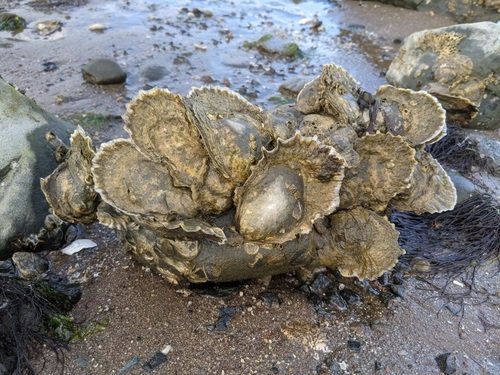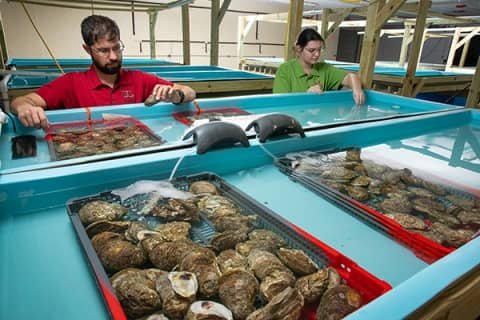
Are you thinking about starting a floating oyster farm? This innovative aquaculture method offers a promising path for the sustainable production of seafood, particularly bivalves like the Virginia oyster, also known as the Atlantic oyster. But before diving in, it’s crucial to understand the economics and profitability.
A team of researchers from Mississippi State University and Louisiana State University & LSU AgCenter analyzed the costs, break-even prices, and profits for multiple operational scales of a floating oyster farming operation (Crassostrea virginica), ranging from just 27,000 oysters planted on half an acre (0.20 ha) to 1.28 million oysters planted on four acres (1.61 ha).
Traditional vs. Floating Oyster Farming
Traditionally, oysters are harvested from natural reefs or planted on the seabed using cultch (materials to which oysters can attach). Suspended oyster farming in the water column offers several advantages:
- Combats habitat loss: It doesn’t rely on increasingly scarce natural reefs.
- Improved control: Farmers have more control over the growth and quality of the oysters.
- Reduced competition: Off-bottom oysters face less competition for food and space.
Scaling Up for Success
The study investigates operations ranging from a modest half-acre with 27,000 oysters to a larger four-acre farm with 1.28 million oysters. The analysis focuses on the critical first five years, considering factors such as:
- Initial costs: Setting up your oyster farm involves initial investments in equipment, infrastructure, and permits.
- Environmental fluctuations: Unpredictable weather events can affect oyster growth and survival.
- Restocking and mortality: The number of oysters you plant and their survival rate play a significant role in overall yield.
- Sales strategy: Who you sell your oysters to (restaurants, wholesalers, etc.) and the price per oyster will impact your revenue.
Cost Considerations
The study estimates that total annual costs range from approximately $50,000 for a single line of floating bags to $250,000 for a larger setup with twenty-four lines. These costs cover:
- Depreciation: The gradual decrease in value of your equipment over time.
- Interest: Any financial costs associated with starting up your farm.
- Labor: The workforce needed for maintenance, harvesting, and other tasks.
- Fuel: Costs associated with operating boats and other machinery.
- Seed: The cost of purchasing young oysters for planting.
- Other expenses: Additional costs like insurance, permits, and various supplies.
Break-Even Point: The Price of Profit
The study also calculates the average break-even price per oyster over five years. This is the price at which you need to sell your oysters to cover all your expenses. Here’s what the research revealed:
- Smaller operations: For a half-acre (0.20 ha) farm with 40,000 oysters, the break-even price is estimated at $2.57 per oyster.
- Medium-sized farms: A two-acre (0.80 ha) farm with 480,000 oysters could break even at around $0.71 per oyster.
- Large-scale production: For a four-acre (1.61 ha) operation with 960,000 oysters, the break-even price drops to an estimated $0.52 per oyster.
Economies of Scale: The Key to Profitability
The research aligns with previous findings: profitability can be challenging for smaller oyster farms. The study suggests that farms planting at least 720,000 oysters on three acres might be the threshold for achieving a positive average annual profit. This highlights the importance of economies of scale in this type of aquaculture.
Conclusion
This research provides valuable insights for aspiring oyster farmers. By carefully considering the cost structure, break-even prices, and the importance of scale, you can make informed decisions to optimize your farm’s profitability and navigate the exciting world of oyster aquaculture.
Key takeaways from the study are:
Stay Always Informed
Join our communities to instantly receive the most important news, reports, and analysis from the aquaculture industry.
- High initial costs: Setting up a suspended water column oyster farm is expensive. A single line of floating bags can cost over $6,000, and larger operations require an even greater investment.
- Economies of scale matter: The study shows that larger farms achieve lower break-even prices per oyster, making them more profitable. Smaller operations planting fewer than 480,000 oysters are unlikely to be profitable in the first five years. Only farms planting at least 720,000 oysters show a positive profit expectation.
- Market uncertainties: The study raises concerns about the market’s ability to absorb large quantities of oysters produced through suspended methods. Producers may need to find alternative buyers or markets, which could affect profitability.
- Seed availability: Suspended oyster aquaculture relies on hatchery-reared seed, which is currently scarce. Regulatory hurdles further limit access to this crucial resource.
- Triploid advantage: Triploid oysters, a faster-growing non-reproductive variety, offer a potential summer production advantage, but their availability is even more limited.
- Storm vulnerability: Despite the perception of mobility, off-bottom equipment and infrastructure are susceptible to damage from tropical storms.
- Subsidies and market distortion: Some states subsidize off-bottom oyster farming, but this can distort market signals and create an unrealistic picture of profitability. The removal of such subsidies could negatively impact the entire supply chain.
- Insurance and additional considerations: The study acknowledges limitations, such as not considering insurance or economic differences between diploid and triploid seed. More research is needed to explore these and other factors, such as timing of mortality and collaborative production models.
Contact
Daniel R. Petrolia
Department of Agricultural Economics, Mississippi State University
Mississippi State, MS, USA
Email: d.petrolia@msstate.edu
Reference (open access)
Petrolia, D. R., & Caffey, R. H. (2024). Economic analysis of off-bottom oyster culture. Aquaculture Economics & Management, 1–29. https://doi.org/10.1080/13657305.2024.2365203
Editor at the digital magazine AquaHoy. He holds a degree in Aquaculture Biology from the National University of Santa (UNS) and a Master’s degree in Science and Innovation Management from the Polytechnic University of Valencia, with postgraduate diplomas in Business Innovation and Innovation Management. He possesses extensive experience in the aquaculture and fisheries sector, having led the Fisheries Innovation Unit of the National Program for Innovation in Fisheries and Aquaculture (PNIPA). He has served as a senior consultant in technology watch, an innovation project formulator and advisor, and a lecturer at UNS. He is a member of the Peruvian College of Biologists and was recognized by the World Aquaculture Society (WAS) in 2016 for his contribution to aquaculture.




